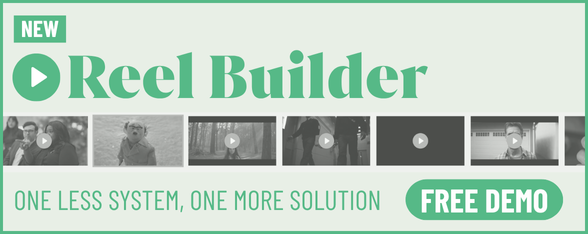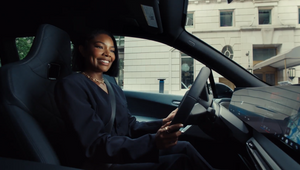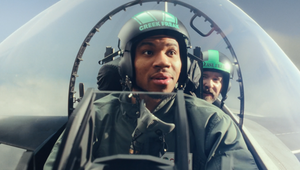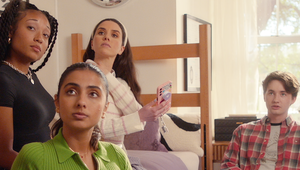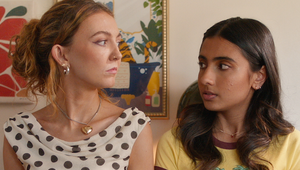
The Directors: Kelsey Taylor

With a keen eye for cinematic excellence and an impeccable sense of comedic timing, this fearless storyteller crafts masterpieces that effortlessly entwine quick wit, visual artistry, and powerful narratives that touch the soul.
Creative connoisseur and filmic polymath Kelsey Taylor began her filmmaking journey as a photographer and cinematographer. Kelsey attends to every frame with a fervent passion for imagery. Steeping each scene in impactful emotion, her natural talent for working with casts nurtures breath taking performances.
From her viral short film 'ALIEN: SPECIMEN' to the award-winning 'Alone in Tombstone,' her glorious portfolio has caught eyes, captured hearts, and garnered wild acclaim.
However bold behind the camera, Kelsey holds an irrational and very intense fear of slugs.
Name: Kelsey Taylor
Location: Long Beach, California
Repped by/in: US - Eleanor, UK - Eleanor
Awards: Academy Nicholl Fellowship Screenwriting Competition Quarterfinalist for 'A LONG WAY HOME,' Academy Nicholl Fellowship Screenwriting Competition semi finalist for 'THE BAD THINGS,' AdAge 2020’s top 10 Holiday Ads (#2), L.A. Addy Awards (Bronze)
LBB> What elements of a script set one apart from another? What sort of scripts get you excited to shoot them?
Kelsey> For me, it's definitely story. What is the inherent premise? Is it clear what the goal is? Is there a good story to be told, even in 15 seconds? In everything I do, I'm looking for that designing principle of what’s being told and how it's being told.
LBB> What’s your approach to creating a treatment for a spot?
Kelsey> With the treatments, again, it’s that designing principle idea. I try to think about it like, okay, if I was sitting on my couch, what would I want to watch? What should this ad be? Instead of getting caught up in the technicalities of it, what would I actually want to see? And that sounds absolutely crazy, but somehow stepping back and removing yourself from the work makes it easier to visualise.
There's so many different ways to approach something. For me, it's a matter of, like, what's the right take for the spot. I think that's why my work ends up being very eclectic. I ask, what's the right box to put this story in? Each story has its own box. I have horror and comedy and sentimental stuff, because, for each spot, that was the box that it was supposed to go in, so I put it there.
LBB> How important is it for you to do research and understand that strategic and contextual side of the ad?
Kelsey> It’s important. The goal is that everyone comes out of making a commercial happy. We're all trying to sell something. Some of us are trying to sell a product. Some of us are trying to tell a good story. It's important to understand why people are making what they're making. I can definitely rely heavily on the agency to know what their branding is. That's their job, to be the people who translate to us. It's important to know their big picture. You want everyone pulling in the same direction.
LBB> What type of work are you most passionate about - is there a particular genre or subject matter or style you are most drawn to?
Kelsey> This one's tough because I do feel like my tastes are very eclectic. I love musicals. I love horror movies. I enjoy comedy. I really do enjoy it all. And I think Robert Zamix is one of those directors that I really, really like because he's done a movie in every genre, and he's done it well. Really well.
I'm trying to figure out what the thread going through my work is. There’s an edge of comedy to everything, an edge of levity, I think, and keeping things grounded.
I’m drawn to subject matter that deals in perspectives and shifting perspectives. We're all the heroes of our own story. And so I like showing how everyone can be a little bit right and a little bit wrong all at the same time.
LBB > What misconceptions about you or your work do you often encounter?
Kelsey> People just see me as a director. There’s a misconception that I'm just a director. I've worked in so many other roles. I've been a DP, I was an AD for a long time, an editor - all that comes with me when I'm a director. I have all these other tools in my toolkit that I bring to the table. I think it just makes me a more well rounded director. I’m involved in every aspect of filmmaking.
You’ve got to know your medium. I think a lot of people who work in film don't, at least when starting out. They see things as a stage play or by how you feel it. Film is very concretely told through images. It's shot to shot to shot and shifting perspectives and how you frame things and how the camera moves. It's all working together. And then you add on music and sound and acting - all these different facets that you can use to sculpt something. I think if you don't have an understanding of all those tools, then you're not using the medium to its full capacity.
LBB> What's the craziest problem you've come across in the course of a production, and how did you solve it?
Kelsey> On To Kill a Wolf, we had snow. We started the morning with snow, and then by the afternoon, the snow was gone. And so we were like, do we reshoot it or not reshoot it? We just ended up changing the framing and redesigning our shots to make it work.
In terms of ads, what we always run into is at lunchtime, we haven't shot enough. I feel like once you sit down you're like, okay, how do we turn up the pace? One shoot, we got to lunch, and we shot, like, three shots out of 30. And I've never ever been that behind in my life. That was by far the most dire. It just turned into a whirlwind of efficiency, getting it done. Working faster. Getting everyone on the same page, and knowing where to compromise. That's the thing that's useful about the ad head - you know where you can and can't cut corners. We still went into OT, but it could have been a lot worse. It should have been a two day shoot, and it was a 13 hour day instead.
LBB> How do you strike the balance between being open and collaborative with the agency and brand client while also protecting the idea?
Kelsey> I’m on the more collaborative side of things, and I'm always respectful of the idea. The agency brought us the idea. They are the people who came up with this. They've been working on it for much, much longer. I see my role as being here to help them realise their take on it, but also give them new ideas and a fresh view of it. I offer a new perspective on what they've come up with. I enhance it, making it bigger and better.
Each story has its own box. What are the key elements that define that box? Which key elements are important and shouldn't bend. It depends on the project.
Casting and locations can make or break something really easily.
For one period piece spot, we went and looked at a bunch of Victorian looking houses. They were kind of the vibe. And then there was one that was like a full on castle. I was like, it's got to be this one. It needs to be. We should really push for this. Otherwise the whole concept is going to crumble. So, I like to ask, what are those important things that will crumble if you don't get them right?
LBB> Your work is now presented in so many different formats. To what extent do you keep this in mind while you're working? And to what degree is it possible to do so?
Kelsey> Aspect ratio is just an ongoing battle. Nine by 16 and 16 by nine are direct opposites of each other. You can't get a good frame with both. One of them is going to be compromised. So I feel like I usually try to prioritise the 16 by nine because people usually watch that format on the television. So, it's the biggest place that they'll see it. On their phone, it's a little bit more forgiving. Some might argue that the phone is more important, because that's where most people will see it, but I don't know. Sometimes I see videos on YouTube where you have your phone turned horizontally, and it's still playing the nine by 16 videos! And you're like, what's the point? I don't know. But I don't have a great solve.
One thing I do that's a nerdy camera trick is shoot with the whole sensor. So like, if this is 16 by nine and this is nine by six, we shoot four by three. So then you get a little bit more on the top and a little bit more on the bottom.
It doesn't solve your problems. It just makes it a little less aggravating. Yeah, I don't think it's really possible to shoot for all formats all at once, all the time.
LBB> What's your relationship with new technology? And if at all, how do you incorporate future facing tech in your work?
Kelsey> I've seen lots of really cool things with VR and documentary storytelling where you can sit there and just listen to people tell their stories. That being said, you don't need fancy things to tell a story. People make movies on their iPhones that are good, and people still shoot film. It doesn't matter what the format is, as long as the story is good.
I do think with all this technology, unless you did it first, it can lower the bar for storytelling. It can be more of a gimmick than it is enhancing what we're doing. If people aren't required to use their imagination and just want to know exactly what it's going to be before it's been done, we lose some of the movie magic.
There's too many books about this to not freaking out right now. We've been warned and warned! We'll see what happens.
LBB> Last but not least, which pieces of work do you feel really show off what you do best and why?
Anything that kind of shows how eclectic my work can be, the range of my work. Maybe the 'ALIEN: SPECIMEN' short film I did, 'Haunting' for Call of Duty, 'Make it One to Remember' for PayPal, and 'The Unwritten Rules of the Road' for Volkswagen.






